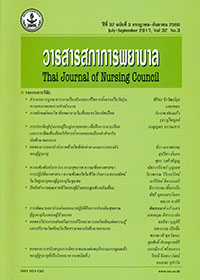ภาพลักษณ์ของวิชาชีพพยาบาลในสื่อละครโทรทัศน์ไทย
Keywords:
image, stereotypical ideas, nursesAbstract
Objective: To examine the images of the nursing profession as portrayed in Thai
television drama series.
Design: Qualitative research.
Methodology: This study examined a sample of 17 drama series broadcast on Thai free television channels 3, 5, 7, 9 and Thai PBS from 2005 to 2015. Out of a total of 931, the 17 television drama series were chosen by means of purposive sampling, based on the condition that they featured characters in the nursing profession. The data were analysed using content analysis, based on Stuart Hall’s theory of representation in the media.
Results: The images of nurses in the selected drama series could be divided into 6 major groups. The positive images depicted nurses as committing themselves to their professional ideology, providing patients with protection and possessing ideal characteristics beftting well-bred ladies. The negative images showed nurses as servants, sex objects and portrayers of negative female attributes.
Recommendations: This study showed Thai TV drama producers’ portrayal of the nursing profession was based on stereotypical ideas. Such portrayal was far from accurate, failing to take into consideration the intricate and diverse dimensions of the profession. The fndings of this study could help drama producers realise the negative impact that such inaccurate images might have on the nursing profession and any
organisations associated with the nursing profession. Also, this study’s fndings could be used for planning proactive approaches to seeking the media’s cooperation in presenting positive and accurate images of the nursing profession.
Downloads
References
in Boromarajonani College of Nursing, Songkhla. SDU Research Journal Sciences and Technology. 2016;
12(3), 147-63. (In Thai).
2. Rojanasupot P. The nurse in the public image [Master’s thesis]. Chiang Mai: Chiang Mai University; 1998.
(In Thai).
3. Sripanyasakul M, Lertsakornsiri M, Eaim-Yingpanich R. The alternative relation between the image of nurses
& nursing professions and the intention of mathayom suksa six students in Bangkok for nursing further
education. Bangkok: Saint Louis College; 1999. (In Thai)
4. Hinviman S. Read television: cultural politics on television screen. Bangkok: Paragraph; 2015. (In Thai)
5. Jitrattikorn A. Thai television series and ASEAN audiences: cultural studies of cross-border media in
ASEAN. Chiang Mai: Center for ASEAN Studies, Chiang Mai University; 2016. (In Thai).
6. Kaewthep K. Watching illusion: gender politics in television series. Bangkok: Gender Press; 1993.
(In Thai).
7. Prachakul N. Prelude in women and society in Thai literatures in the soap bubble era. Chalearnporn S.
(Author). Bangkok: Matichon; 2005. (In Thai).
8. Bridges M. Literature review on the images of the nurse and nursing in the media. Journal of advanced
nursing. 1990; 15(7), 850-54.
9. Kalisch A, Beatrice J. A comparative analysis of nurse and physician characters in the entertainment media.
J Adv Nurs. 1986; 11(2), 179-95.
10. Jinks M, Eleanor B. Angel, handmaiden, battleaxe or whore? A study which examines changes in newly
recruited student nurses’ attitudes to gender and nursing stereotypes. Nurse education today. 2004; 24(2),
121-7.
11. O’Lynn E, Russell E. Men in nursing: History, challenges, and opportunities. New York: Springer
Publishing Company; 2006.
12. Summers S, Harry S. Saving lives: Why the media’s portrayal of nurses puts us all at risk. London: Kaplan
Pub; 2009.
13. Hoeve Y, Gerard J, Petrie R. The nursing profession: public image, self-concept and professional identity.
A discussion paper. Journal of advanced nursing. 2014; 70(2), 295-309.
14. Sammawart S. Nursing image. Ramathibodi Nursing Journal. 1995; 1(1), 88-90. (In Thai).
15. Hall S. Representation: cultural representations and signifying practices. London: Sage; 1997.
16. Boonmee T. Semiotic revolution of Saussure: the path ways to post-modernists. Bangkok: Vipasa. 2004.
(In Thai).
17. Phothisita C. Sciences and arts of qualitative research.Bangkok: Amarin Printing and Publishing. 2004.
(In Thai).
18. Bureau of Nursing, Ministry of Public Health. Ministry of Public Health order on offcers who provide medical
care service to patients in medical organizations regarding the controls of nursing, midwifery professions or nursing
and midwifery profession: issued on 2010. http://www.nursing.go.th/rules/Binder1.pdf (access 10
November 2016). (In Thai)








